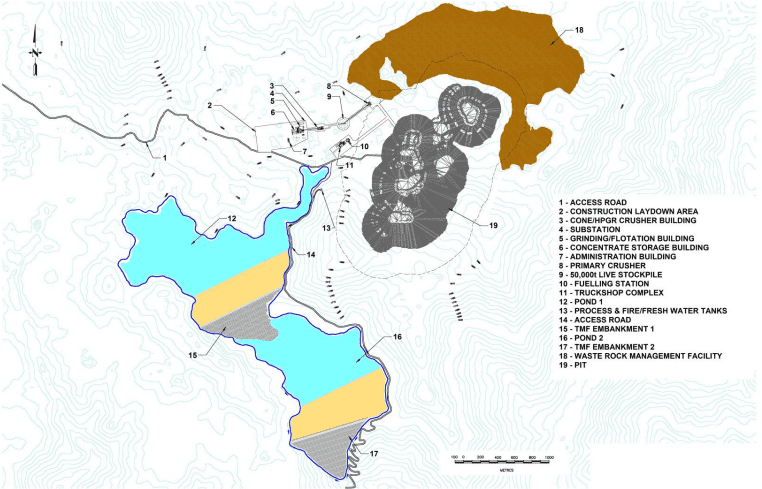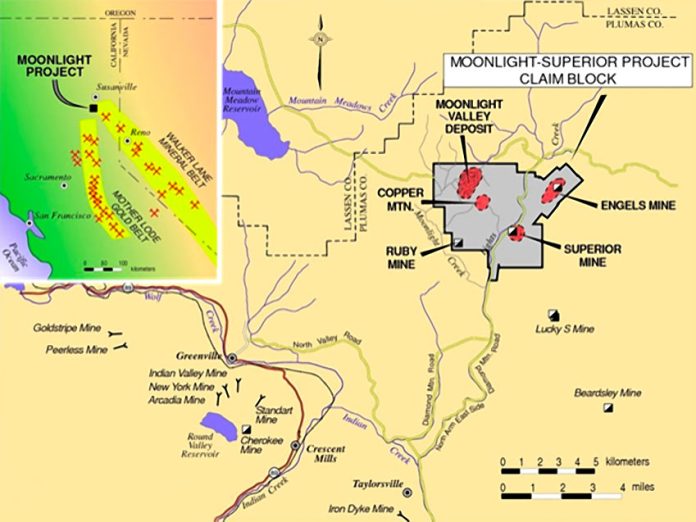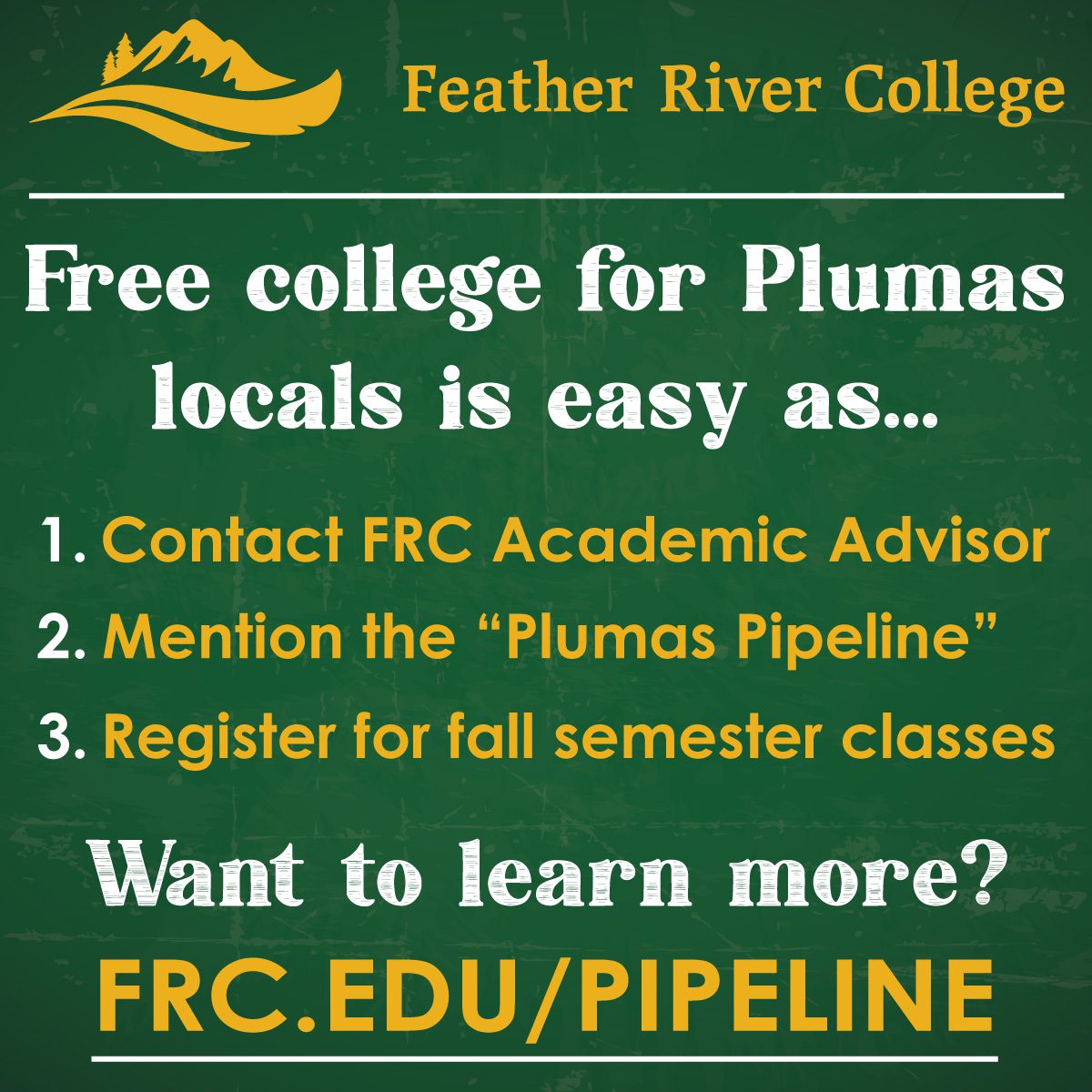Almost a year ago, on April 26, 2023, Toronto-based US Copper Corp submitted an application for a determination of vested rights to mine the historic Engels and Superior mines near Greenville. Now, a final decision could be just weeks away.
The intervening months have seen an official Plumas County staff report; contentious zoning administration meetings; the hiring of Best, Best and Krieger as outside legal consultants to the county; and the formation of the Feather River Watershed Alliance, a new grassroots environmental organization with attorneys of its own.
US Copper’s proposals
US Copper Corp is a Canadian junior company. “The role of a junior mining company,” said CEO Steve Dunn in a written interview, “is to identify and advance mineral deposits, through exploration and engineering studies, to the point where economic viability can be demonstrated.”
Mining and development are risky, Dunn said. “A project that has historic production and resources still available” mitigates that risk significantly, he added. The Engels property includes two such historical copper mines: Engels and Superior, with two other known deposits nearby: Moonlight and Lamb’s Ridge. Together they represent an estimated 1.3 billion pounds of copper.
“Very few deposits of this size ever become available,” said Dunn.
The project has other attractive features for US Copper. Because the site is in the United States, the property title is secure. The deposits are close to the surface, which “keeps the engineering straightforward,” Dunn said. There is adequate infrastructure, which also helps the balance sheet. Vested mining rights — if approved — would be another benefit.
“Very few deposits of this size ever become available.”
Steve Dunn, CEO, US Copper Corp
The question of vesting at Engels and Superior
“Vesting” is a grandfather clause, enshrined in both state law and county code, that allows businesses that existed prior to zoning ordinances to continue operations without applying for permits. They also avoid completing a California Environmental Quality Act analysis, which is typically part of a permit application.
Vested rights are linked to locations, rather than to a specific owner or operator. For a mine to qualify, the site must have been used for the same purpose prior to either the oldest relevant local regulation or the Surface Mining and Reclamation Act of 1975, and the owners must not have “intentionally” waived or abandoned their rights, or made “substantial changes” to the operation.
Both Engels and Superior were active copper mines beginning in the 1880s, long before the first county zoning ordinance in 1958. According to the US Copper filing, while large-scale copper operations ceased in the 1930s, exploratory drilling programs and aggregate mining activities continued at intervals through the present day.
“Our review of the facts and applicable law supports the existence of a vested mining right at this site. We are hopeful the zoning administrator will agree with us. If not, we will consider our options at that time,” said Dunn.
The Plumas County Planning Department is currently assessing US Copper’s vested rights application, along with related material including a county staff report, the minutes of zoning administration meetings, and written public comments. Staff are working with the help of legal consultants BBK Law.
BBK is “in the process of independently reviewing the information in the record and will confirm and/or clarify the record information, as needed, using supplemental research and sources,” said Plumas County Planning Director Tracey Ferguson in a March 15 email. BBK did not respond to a request for comment.
Among the written comments BBK will be reviewing is a 267-page package consisting of a letter and supporting documentation from Shute, Mihaly & Weinberger, attorneys for the Feather River Watershed Alliance. The mission of the newly formed grassroots environmental advocacy group, based in Indian Valley, is to “unite people around ensuring the health and wellness of the Feather River watershed,” according to the group’s general information document. The attorney letter disputes US Copper’s claim to vested mining rights at Engels and Superior on the grounds that both sites were dormant when the county adopted zoning ordinances in 1958, that extended inactivity qualifies as abandonment under the law, and that the scope of mining articulated in the petition goes beyond what would be allowed by vested rights, were they applicable.
What might the future look like?
There are three main exterior components to an open pit mining operation, explains Javad Sattarvand, associate professor at the University of Nevada, Reno, and chair of the Mining and Metallurgical Engineering Department: a pit, a waste dump and a tailings facility.
Typically, open pit copper mine operations begin by removing the topsoil and overburden material that lies on top of ore and depositing it in a waste dump. Often at the end of the mining process the waste dump may be backfilled or reclaimed to resemble a natural slope.
Ore is then mined. “Usually there is 1% or less copper in our ore,” Sattarvand said. The US Copper website estimates 252 million tons at 0.25% for Moonlight, 54 million tons at 0.41% copper for Superior, and an unconfirmed historical resource of 19 million tons at 0.63% for Engels. That means, after processing, over 99% of the rock will become finely ground waste, or tailings. A tailings facility is created by engineering a dam or embankment to create pools where that finely ground waste material can settle as sediment, said Sattarvand.
The US Copper website includes a Preliminary Economic Assessment for the Moonlight deposit, describing a large open pit mine running 24 hours a day, seven days a week, with processing taking place on site. However, Dunn notes that the Moonlight assessment is “not a full-fledged mine plan, but an economic study to establish whether an ore body might be profitable at certain commodity price levels.” As such it is “subject to major changes.”

As for the Engels and Superior sites specifically, he said, “We have not yet developed any mining plans for either the Engels or Superior deposits based on current economic conditions. We are currently defining the oxide resource at Engels and doing some metallurgical tests. These studies are needed before we can begin planning any possible mining options.
“It is possible that any mining operation would eventually include adjacent U.S. Forest Service lands, and it would then be necessary to obtain approval of a plan of operations (permit) from the Forest Service before that could happen.”
Of the future, Dunn said, “Our hope is that the project that includes the Engels/Superior/Moonlight deposits becomes the largest employer in Plumas County for decades to come, providing large direct and indirect benefits to the entire community … something that the entire community can be proud of.”
The Moonlight economic assessment indicates an estimated workforce of 321. An FAQ released by the company and entered into the planning department record indicates direct employment “upwards of 30-50 full-time workers with an average wage in excess of $80,000 per year.” For comparison, large employers in Plumas currently include Pacific Gas and Electric Co. (84 employees), Feather River College (125 full-time, 214 part-time and student workers), the USDA Forest Service (approximately 200, not including seasonal, employees), Plumas District Hospital (240 employees, not including travelers or contractors), and the county itself, which, when fully staffed, employs about 330 people.
Water quality concerns regarding Engels, other Plumas County mines
The Feather River Watershed Alliance was born out of public concern over the potential environmental ramifications of opening a large pit mine like the one described in the Moonlight economic assessment.
“Mining operations such as this have a legacy of destroying ecosystems, watersheds and communities across the globe for decades,” according to the group’s general information document.
“Mining operations such as this have a legacy of destroying ecosystems, watersheds and communities across the globe for decades.”
Feather River Watershed Alliance general information document
In addition to the environmental and water quality concerns associated with mining generally, Dan Kearns, chair of the FRWA, has raised an issue specific to the Engels and Superior sites: The presence of sulfide in the ore and surrounding rock has the potential to create “acid mine drainage,” he said. Acid mine drainage occurs when mining exposes sulfide rock to air and water, creating sulfuric acid, which releases heavy metals into the water table, damaging riparian ecosystems, according to the nonprofit EarthWorks.
When the US Copper vested rights application was released for public comment in advance of an Oct. 11, 2023, zoning administration meeting, residents of the North Arm of Indian Valley began researching mining in Plumas County more generally. They realized that the county “is not SMARA-compliant” with regard to existing mines, said Kearns. The county has hired consultant Land Logistics for mine inspections and reporting.
“We were trying to prevent this big environmental disaster and in the process we found out that there are a bunch of little environmental disasters going on right under our noses,” Kearns said.
The FRWA’s aims now are to support Plumas County “in denying vested rights to US Copper for the Engels and Superior claim properties,” and “in adhering to county, state and federal regulations,” Kearns said.
Intentional abandonment can be a difficult thing to prove. The Shute, Mihaly & Weinberger letter states, “when a site goes unmined entirely for well over half a century, it is clear evidence that the property’s owners did not intend to continue mining.”
Dunn said, “Norman Lamb has stewarded the Engels and Superior Mines for more than 40 years. … These projects would be the culmination of half a lifetime’s worth of work both he and Katherine Lamb have dedicated themselves to.” The Lambs declined to comment for this story.
While not opposed to extracting minerals in general, Kearns said that he would first like to know that the mines in Plumas County are safe, and that they are being monitored by responsible people and transparent processes. “And then, if we are going to talk about mining in this county, we should look at our own rules and regulations, and the state and federal regulations, and consider what we want to allow.”
Can a neighboring county’s story provide a glimpse into the future?
The Engels proposal has drawn comparisons to another case: the Idaho-Maryland gold mine in Nevada County. In that case, a Canada-based junior company applied to reopen a historic Sierra Nevada mine and sparked community opposition.
The mining company Rise Gold first applied for a use permit to reopen the Idaho-Maryland mine in November 2019. Opposing Rise Gold’s efforts was the Community Environmental Advocates Foundation, a nonprofit organization focused on issues related to the environment, sustainability and responsible land use in Nevada County. The CEA’s MineWatch campaign, opposing the reopening of the Idaho-Maryland, is just one of several current projects the group is spearheading.
Ralph Silberstein, president of the CEA Foundation, explained the main goal of the group’s advocacy work is to educate the public on issues that might not be apparent using solid research and accurate facts. “Our mission is to help inform the public about issues in the community that affect their lives,” he said.
“Developers have a lot of power, because they spend a lot on their documents and have marketing people. So it can be hard to get a balanced view,” said Silberstein.
“Developers have a lot of power, because they spend a lot on their documents and have marketing people. So it can be hard to get a balanced view.”
Ralph Silberstein, president, Community Environmental Advocates Foundation
CEA works to “let the community know what it would really be like if the project moved forward.” That involves a lot of outreach: tabling, holding webinars, writing for the paper, and using social media.
The Nevada County use permit process requires the applicant to create a draft environmental impact report, which is made available for public review and comment, after which the planning department makes a recommendation to the board of supervisors. The final decision rests with the board. On May 11, 2023, after about nine hours of public comment over two days, the planning commission voted unanimously to recommend denial of the proposal.
On Sept. 1, 2023, the company submitted an application for vested rights, which would allow them to bypass the EIR and permitting process altogether. On Dec. 14, 2023, Nevada County denied the application on the basis that “the petition failed to provide sufficient evidence to support the finding of a vested right and that, further, any mining operations had been abandoned.”
The county’s response lists several events which, it says, constitute “overt acts or failures to act which demonstrate the intent to abandon” mining operations. Among them are a 1954 deed that reserved some, but not all, mineral rights; liquidation of assets and equipment; and an application to rezone the property as industrial so that it could be used as a lumber mill, which included a restriction on the deed that the property would be used only for wood or lumber products.
While the vested rights application was under consideration, the original 2019 application processes paused. It reactivated after the vesting decision, and the use permit advanced to the final step, in which the county board of supervisors reviewed the planning department recommendation, heard public comment, and ultimately voted 5-0 to deny the use permit and certification of the EIR.
“Of course we were jubilant. You know, we have been fighting this for four years, and so we were very pleased with that.”
Ralph Silberstein, president, Community Environmental Advocates Foundation
“Of course we were jubilant. You know, we have been fighting this for four years, and so we were very pleased with that,” said Silberstein. “There was a lot of pressure on the board of supervisors and on the planning department, but fortunately they stood up, and we feel, did the right thing.”
Even so, the question may not be settled yet. Rise Gold has threatened litigation. Silberstein said May 13 is the deadline to make a legal challenge. He added, “we are watching.”
Rise Gold did not respond to requests for comment.
The FRWA is now, in some respects, where the CEA was four years ago. The CEA had some advantages, however. The group had a wealth of experience to draw on, having already run several campaigns since its founding in 2017. It also had a board member who had worked in the planning department for many years and was able to contribute a deep familiarity with application processes and requirements.
Asked if he has any recommendations for the younger organization, Silberstein noted that “there is a lot of misinformation about how easy it is to get vested rights.” He also recommended securing credible specialists with the right credentials, education and expertise to provide expert testimony. “It really has more impact.”
Finally, he said, “I recommend that they reach out. … We’re happy to help.”
A chance to have your say
The FRWA will hold community meetings at the Historic Taylorsville Hall at 6:30 p.m. March 28, and at the Westwood Community Center at 6:30 p.m. March 29.
“US Copper understands that the community deserves to be involved in the planning and monitoring stages,” said Dunn. Communities deserve “to be protected by the regulators against any and all risks. … It is not uncommon for fears and misinformation to overwhelm the facts surrounding a mining project. US Copper remains committed to getting the real facts out to the public to allow for a meaningful and honest dialogue about our project.”
The Plumas planning department will continue to accept public comment on the vested rights case up to and during the May 8 zoning administration meeting. Comments may be emailed to Tracey Ferguson at traceyferguson@countyofplumas.com or delivered in person at the meeting.






